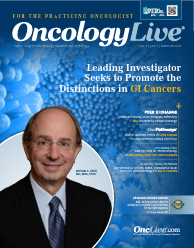Publication
Article
Oncology Live®
Treatment Strategies for Relapsed/Refractory MCL Represent a Unique Challenge
Author(s):
Despite the breakthroughs in the development of therapeutic regimens for patients with mantle cell lymphoma, variability in treatment pathways presents a unique hurdle in determining the appropriate course of care following disease progression.
Caron Jacobson, MD, MMSc

Despite the breakthroughs in the development of therapeutic regimens for patients with mantle cell lymphoma (MCL), variability in treatment pathways presents a unique hurdle in determining the appropriate course of care following disease progression.
In most patients, MCL requires aggressive induction therapy with regimens such as cytarabine-containing chemotherapy such as hyperfractionated CVAD (cyclophosphamide, vincristine sulfate, doxorubicin hydrochloride, and dexamethasone plus methotrexate and cytarabine) with patients proceeding to allogeneic stem cell transplantation (ASCT).1,2
However, findings have determined that equally effective but less toxic regimens may be available for patients with high-risk, intermediate-risk, and low-risk disease. “If you go to 5 different oncologists [who have patients] with MCL, you’ll probably get 5 different recommendations for up-front treatment of the disease and I think all are right,” said Caron Jacobson, MD, MMSc, during a recent OncLive Peer Exchange®.
Success has been demonstrated with a variety of therapeutic strategies tailored to patients based on risk factors; however, as moderator Bijal Shah, MD, MS, noted, “One of the challenges is that MCL is still an insidious disease. It comes back.”
As part of the discussion, Shah joined a panel of hematologic experts to review current treatment guidelines for the population of patients with relapsed or refractory MCL and how agents such as BTK inhibitors are adding options to the relapsed/refractory setting.
BTK Inhibitors Battling for a Spot in the Second Line
There are limited data on optimal sequencing strategies for patients with MCL who relapse following standard treatment. Authors of the National Comprehensive Cancer Network (NCCN) guidelines for B-cell lymphomas conclude that patients who experience disease progression within 12 months of initiation of second-line therapy following ASCT are associated with a poor prognosis, making the landscape in need of options for this patient population.3
BTK inhibitors offer some hope for investigators looking for ways to crack the code in obtaining deep, durable responses for patients with relapsed or refractory disease. BTK is a key player in the B-cell antigen receptor signaling pathway.4 “BTK is a critical link in this disease,” Michael Wang, MD, said. “If we use inhibitors to hit off this link and inhibit the pathway, then growth signals are blocked, and the lymphoma cells will die. This is an interesting target.”
Ian W. Flinn, MD, PhD, agreed, noting that BTK inhibitors have become a very common go-to second-line therapy for this patient population. “We have 3 BTK inhibitors approved in the second line; ibrutinib [Imbruvica], acalabrutinib [Calquence], and zanubrutinib [Brukinsa], and results of pivotal phase 2 trials showed high response rates, durable remissions with very manageable safety profiles for each of these agents,” Flinn said.
Ibrutinib was the first BTK inhibitor approved for the treatment of patients with relapsed or refractory MCL based on results of the phase 2 PCYC-1104-CA trial (NCT01236391).5 The overall response rate among 111 patients with a median of 3 prior lines of treatment was 65.8% (95% CI, 56.2%-74.5%) with a median duration of response (DOR) of 17.5 months (95% CI, 15.8-not estimable [NE]).
In an extended follow-up from a pooled analysis of 370 patients, investigators determined that patients who received ibrutinib as a second-line treatment option fared better than those who received the agent in the third line or later. Specifically, the overall response rate in the entire population was 69.7% vs 77.8% (n = 99) for those who had 1 prior line of therapy vs 66.8% (n = 271) among those who received more than 1 prior line of therapy.6
Acalabrutinib was granted accelerated approval based on results of the phase 2 ACE-LY-004 trial (NCT02213926). Among 124 patients who received the agent at a dose of 100 mg twice daily, the overall response rate was 81% (95% CI, 73%-87%) with a complete response (CR) rate of 40% (95% CI, 31%-49%).7 The median DOR was NE (range, 1-20).
In a final report of data from the trial, with a median follow-up of 38.1 months, the median overall survival (OS) was 59.2 months (95% CI, 36.5-NE). In patients who received 2 or more prior therapies, the median OS was 55.9 months (95% CI, 27.7-NE) and was not yet reached (95% CI, 36.3-NE) in those with 1 prior therapy. Acalabrutinib maintained a high overall response rate of 81% (95% CI, 74%-88%) with a CR rate of 48%.8
Finally, the third approved agent, zanubrutinib, was granted accelerated approval from the FDA based on results of the phase 2 BGB-3111-206 trial (NCT03206970) and the phase 1/2 BGB-3111-AU-003 trial (NCT02343120).9 Among 86 and 32 patients, respectively, the agent elicited an overall response rate of 84% (95% CI, 74%-91%) and 84% (95% CI, 67%-95%). In BGB-3111-206 the CR rate was 59%; because scans were not required for response assessment in BGB-3111-AU-003, the CR rate was lower, at 22%. The DORs were 19.5 months (95% CI, 16.6-NE) and 18.5 months (95% CI, 12.6-NE), respectively.
In terms of distinguishing between BTK inhibitors, Brian Hill, MD, noted that head-to-head trials in other hematologic malignancies have provided some context for investigators. “What we’ve learned through randomized, head-to-head trials in [chronic lymphocytic leukemia] CLL and in Waldenström [macroglobulinemia; WM] is that results have demonstrated noninferiority of both acalabrutinib and zanubrutinib and an improved safety profile [vs ibrutinib],” he said. These trials specifically include the phase 3 ASPEN trial (NCT03053440), in which investigators compared zanubrutinib with ibrutinib as treatment for patients with WM, and the phase 3 ACE-CL-006 trial (NCT02477696) evaluating acalabrutinib vs ibrutinib as treatment for patients with CLL.10,11
“We still have patients who receive ibrutinib, but we see lower rates of atrial fibrillation with the newer agents, possibly lower bleeding risk, which is a known toxicity of the covalent BTK inhibitors,” said Hill, adding that most lymphoma specialists have moved toward acalabrutinib and zanubrutinib.
Wang tossed another BTK inhibitor into the discussion: pirtobrutinib (LOXO-305). The highly selective, noncovalent BTK inhibitor has demonstrated efficacy in patients with MCL who have been previously treated with a BTK inhibitor. “Instead of binding with BTK covalently and not letting it go; [pirtobrutinib] uses noncovalent binding,” Wang explained. “It binds and then lets it go, it’s a dynamic process. This way is a brand-new way to inhibit the protein and it’s very interesting.”
The phase 1/2 BRUIN trial (NCT03740529) evaluated the efficacy of pirtobrutinib among 134 patients with MCL who had received a minimum of 2 prior lines of treatment; 120 individuals (90%) had received prior treatment with a BTK inhibitor. In total, 110 who had received prior BTK therapy and 11 who were BTK inhibitor naïve were evaluable. The overall response rates were 51% (95% CI, 41%-61%) and 82% (95% CI, 48%-98%), respectively.12 The CRs were 25% and 18%, respectively. At a median follow-up of 8.2 months (range, 1.0-27.9), 60% of responders had an ongoing response (n = 36/60).
Wang is optimistic that the agent will soon enter the landscape as a viable option in future lines of therapy. “Even if a patient is receiving a BTK inhibitor and you think in the future it might stop working, the next time [we determine a treatment] we can use this new [agent]. I hope that the drug will become available to the patients very soon.”
References
- Schieber M, Gordon LI, Karmali R. Current overview and treatment of mantle cell lymphoma. F1000Res. 2018;7:F1000 Faculty Rev-1136. doi:10.12688/f1000research.14122.1
- Hyper-CVAD. National Cancer Institute. Updated August 13, 2015. Accessed January 20, 2022. https://bit.ly/3FPzgu2
- NCCN. Clinical Practice Guidelines in Oncology. B-cell lymphomas, version 5.2021. Accessed January 21, 2022. https://www.nccn.org/professionals/physician_gls/pdf/b-cell.pdf
- Owen C, Berinstein NL, Christofides A, Sehn LH. Review of Bruton tyrosine kinase inhibitors for the treatment of relapsed or refractory mantle cell lymphoma. Curr Oncol.2019;26(2):e233-e240. doi:10.3747/co.26.4345
- Imbruvica. Prescribing information. Pharmacyclics Inc; 2020. Accessed January 21, 2022. https://bit.ly/3tZ525s
- Rule S, Dreyling M, Goy A, et al. Ibrutinib for the treatment of relapsed/refractory mantle cell lymphoma: extended 3.5-year follow up from a pooled analysis.Haematologica. 2019;104(5):e211-e214. doi:10.3324/haematol.2018.205229
- Calquence. Prescribing information. AstraZeneca Pharmaceuticals, LP; 2021. Accessed January 21, 2022. https://bit.ly/3tRcS13
- Wang M, Rule S, Zinzani PL, et al. Acalabrutinib monotherapy in patients with relapsed/refractory mantle cell lymphoma: final results from a phase 2 study. Hematol Oncol. 2021;39(suppl 2):213-216. doi:10.1002/hon.58_2880
- Brukinsa. Prescribing information. BeiGene USA Inc; 2021. Accessed January 21, 2022. https://bit.ly/32vTtYi
- Tam CS, Opat S, D’Sa S, et al. A randomized phase 3 trial of zanubrutinib vs ibrutinib in symptomatic Waldenström macroglobulinemia: the ASPEN study. Blood. 2020;136(18):2038-2050. doi:10.1182/blood.2020006844
- Byrd JC, Hillmen P, Ghia P, et al. Acalabrutinib versus ibrutinib in previously treated chronic lymphocytic leukemia: results of the first randomized phase III trial. J Clin Oncol. 2021;39(31):3441-3452. doi:10.1200/JCO.21.01210
- Wang M, Shah NN, Alencar AJ, et al. Pirtobrutinib, a next generation, highly selective, non-covalent BTK inhibitor in previously treated mantle cell lymphoma: updated results from the phase 1/2 BRUIN study. Blood. 2021;138(suppl 1):381. doi:10.1182/ blood-2021-149138
























%20(2)%201-Recovered-Recovered-Recovered-Recovered-Recovered-Recovered-Recovered-Recovered-Recovered-Recovered-Recovered-Recovered-Recovered-Recovered-Recovered-Recovered-Recovered.jpg?fit=crop&auto=format)
%20(2)%201-Recovered-Recovered-Recovered-Recovered-Recovered-Recovered-Recovered-Recovered-Recovered-Recovered-Recovered-Recovered-Recovered-Recovered-Recovered-Recovered-Recovered.jpg?fit=crop&auto=format)
